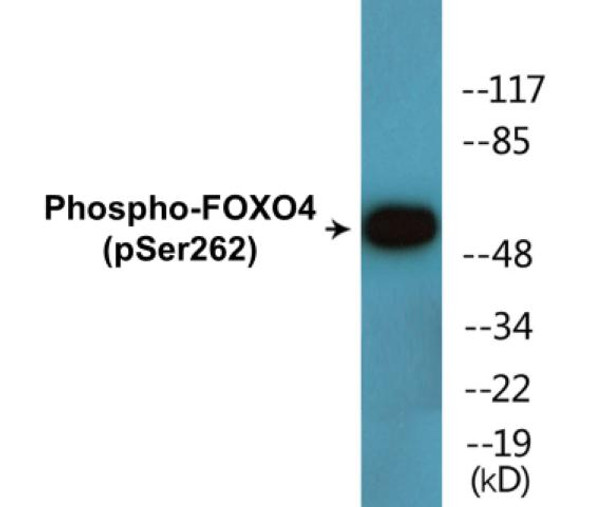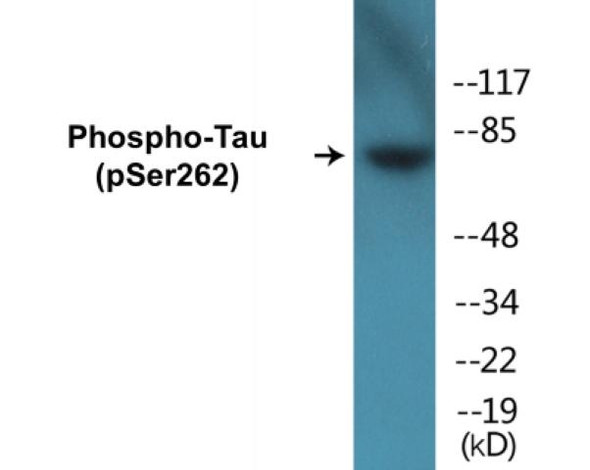Description
FOXO4 (Phospho-Ser262)Colorimetric Cell-Based ELISA Kit
The FOXO4 Phospho-Ser262 Colorimetric Cell-Based ELISA Kit is a highly sensitive and specific assay designed for the accurate detection of phosphorylated FOXO4 at Ser262 in cell lysates. This kit provides reliable and reproducible results, making it ideal for studying the regulation of FOXO4 activity in various biological processes.The phosphorylation of FOXO4 at Ser262 plays a critical role in the regulation of cellular processes such as apoptosis, cell cycle progression, and stress response. Dysregulation of FOXO4 phosphorylation has been implicated in various diseases, including cancer, diabetes, and aging-related disorders, making this kit a valuable tool for researchers interested in understanding the role of FOXO4 in these conditions and identifying potential therapeutic targets.
Overall, the FOXO4 Phospho-Ser262 Colorimetric Cell-Based ELISA Kit offers a convenient and reliable method for quantifying phosphorylated FOXO4 levels in cell lysates, providing valuable insights into the signaling pathways and biological functions regulated by FOXO4.
| Product Name: | FOXO4 (Phospho-Ser262)Colorimetric Cell-Based ELISA Kit |
| Product Code: | CBCAB01629 |
| ELISA Type: | Cell-Based |
| Target: | FOXO4 (Phospho-Ser262) |
| Reactivity: | Human, Mouse |
| Dynamic Range: | > 5000 Cells |
| Detection Method: | Colorimetric 450 nm |
| Format: | 2 x 96-Well Microplates |
The FOXO4 (Phospho-Ser262) Colorimetric Cell-Based ELISA Kit is a convenient, lysate-free, high throughput and sensitive assay kit that can detect FOXO4 protein phosphorylation and expression profile in cells. The kit can be used for measuring the relative amounts of phosphorylated FOXO4 in cultured cells as well as screening for the effects that various treatments, inhibitors (ie. siRNA or chemicals), or activators have on FOXO4 phosphorylation.
Qualitative determination of FOXO4 (Phospho-Ser262) concentration is achieved by an indirect ELISA format. In essence, FOXO4 (Phospho-Ser262) is captured by FOXO4 (Phospho-Ser262)-specific primary (1ø) antibodies while the HRP-conjugated secondary (2ø) antibodies bind the Fc region of the 1ø antibody. Through this binding, the HRP enzyme conjugated to the 2ø antibody can catalyze a colorimetric reaction upon substrate addition. Due to the qualitative nature of the Cell-Based ELISA, multiple normalization methods are needed:
| 1. | A monoclonal antibody specific for human GAPDH is included to serve as an internal positive control in normalizing the target absorbance values. |
| 2. | Following the colorimetric measurement of HRP activity via substrate addition, the Crystal Violet whole-cell staining method may be used to determine cell density. After staining, the results can be analysed by normalizing the absorbance values to cell amounts, by which the plating difference can be adjusted. |
| Database Information: | Gene ID: 4303, UniProt ID: P98177, OMIM: 300033, Unigene: Hs.584654 |
| Gene Symbol: | FOXO4 |
| Sub Type: | Phospho |
| UniProt Protein Function: | FOXO4: transcription factor AFX1 containing 1 fork-head domain. May play a role in the insulin signaling pathway. Involved in acute leukemias by a chromosomal translocation t(X;11)(q13;q23) that involves MLLT7 and MLL/HRX. The result is a rogue activator protein. Two splice-variant isoforms have been described. |
| UniProt Protein Details: | Protein type:Oncoprotein; Transcription factor; DNA-binding Chromosomal Location of Human Ortholog: Xq13.1 Cellular Component: cytoplasm; cytosol; nucleoplasm; nucleus Molecular Function:beta-catenin binding; DNA binding; enzyme binding; identical protein binding; protein binding; sequence-specific DNA binding; transcription factor activity; transcription factor binding Biological Process: cell cycle arrest; insulin receptor signaling pathway; negative regulation of angiogenesis; negative regulation of cell proliferation; negative regulation of smooth muscle cell differentiation; positive regulation of transcription from RNA polymerase II promoter; regulation of transcription, DNA-dependent; stem cell differentiation; transcription from RNA polymerase II promoter |
| NCBI Summary: | This gene encodes a member of the O class of winged helix/forkhead transcription factor family. Proteins encoded by this class are regulated by factors involved in growth and differentiation indicating they play a role in these processes. A translocation involving this gene on chromosome X and the homolog of the Drosophila trithorax gene, encoding a DNA binding protein, located on chromosome 11 is associated with leukemia. Multiple transcript variants encoding different isoforms have been found for this gene. [provided by RefSeq, Jan 2010] |
| UniProt Code: | P98177 |
| NCBI GenInfo Identifier: | 110825720 |
| NCBI Gene ID: | 4303 |
| NCBI Accession: | P98177.5 |
| UniProt Secondary Accession: | P98177,O43821, Q13720, Q3KPF1, Q8TDK9, B7WPJ7, |
| UniProt Related Accession: | P98177 |
| Molecular Weight: | 47,941 Da |
| NCBI Full Name: | Forkhead box protein O4 |
| NCBI Synonym Full Names: | forkhead box O4 |
| NCBI Official Symbol: | FOXO4 |
| NCBI Official Synonym Symbols: | AFX; AFX1; MLLT7 |
| NCBI Protein Information: | forkhead box protein O4 |
| UniProt Protein Name: | Forkhead box protein O4 |
| UniProt Synonym Protein Names: | Fork head domain transcription factor AFX1 |
| Protein Family: | Forkhead box protein |
| UniProt Gene Name: | FOXO4 |
| UniProt Entry Name: | FOXO4_HUMAN |
| Component | Quantity |
| 96-Well Cell Culture Clear-Bottom Microplate | 2 plates |
| 10X TBS | 24 mL |
| Quenching Buffer | 24 mL |
| Blocking Buffer | 50 mL |
| 15X Wash Buffer | 50 mL |
| Primary Antibody Diluent | 12 mL |
| 100x Anti-Phospho Target Antibody | 60 µL |
| 100x Anti-Target Antibody | 60 µL |
| Anti-GAPDH Antibody | 60 µL |
| HRP-Conjugated Anti-Rabbit IgG Antibody | 12 mL |
| HRP-Conjugated Anti-Mouse IgG Antibody | 12 mL |
| SDS Solution | 12 mL |
| Stop Solution | 24 mL |
| Ready-to-Use Substrate | 12 mL |
| Crystal Violet Solution | 12 mL |
| Adhesive Plate Seals | 2 seals |
The following materials and/or equipment are NOT provided in this kit but are necessary to successfully conduct the experiment:
- Microplate reader able to measure absorbance at 450 nm and/or 595 nm for Crystal Violet Cell Staining (Optional)
- Micropipettes with capability of measuring volumes ranging from 1 µL to 1 ml
- 37% formaldehyde (Sigma Cat# F-8775) or formaldehyde from other sources
- Squirt bottle, manifold dispenser, multichannel pipette reservoir or automated microplate washer
- Graph paper or computer software capable of generating or displaying logarithmic functions
- Absorbent papers or vacuum aspirator
- Test tubes or microfuge tubes capable of storing ≥1 ml
- Poly-L-Lysine (Sigma Cat# P4832 for suspension cells)
- Orbital shaker (optional)
- Deionized or sterile water
*Note: Protocols are specific to each batch/lot. For the correct instructions please follow the protocol included in your kit.
| Step | Procedure |
| 1. | Seed 200 µL of 20,000 adherent cells in culture medium in each well of a 96-well plate. The plates included in the kit are sterile and treated for cell culture. For suspension cells and loosely attached cells, coat the plates with 100 µL of 10 µg/ml Poly-L-Lysine (not included) to each well of a 96-well plate for 30 minutes at 37 °C prior to adding cells. |
| 2. | Incubate the cells for overnight at 37 °C, 5% CO2. |
| 3. | Treat the cells as desired. |
| 4. | Remove the cell culture medium and rinse with 200 µL of 1x TBS, twice. |
| 5. | Fix the cells by incubating with 100 µL of Fixing Solution for 20 minutes at room temperature. The 4% formaldehyde is used for adherent cells and 8% formaldehyde is used for suspension cells and loosely attached cells. |
| 6. | Remove the Fixing Solution and wash the plate 3 times with 200 µL 1x Wash Buffer for five minutes each time with gentle shaking on the orbital shaker. The plate can be stored at 4 °C for a week. |
| 7. | Add 100 µL of Quenching Buffer and incubate for 20 minutes at room temperature. |
| 8. | Wash the plate 3 times with 1x Wash Buffer for 5 minutes each time. |
| 9. | Add 200 µL of Blocking Buffer and incubate for 1 hour at room temperature. |
| 10. | Wash 3 times with 200 µL of 1x Wash Buffer for 5 minutes each time. |
| 11. | Add 50 µL of 1x primary antibodies Anti-FOXO4 (Phospho-Ser262) Antibody, Anti-FOXO4 Antibody and/or Anti-GAPDH Antibody) to the corresponding wells, cover with Parafilm and incubate for 16 hours (overnight) at 4 °C. If the target expression is known to be high, incubate for 2 hours at room temperature. |
| 12. | Wash 3 times with 200 µL of 1x Wash Buffer for 5 minutes each time. |
| 13. | Add 50 µL of 1x secondary antibodies (HRP-Conjugated AntiRabbit IgG Antibody or HRP-Conjugated Anti-Mouse IgG Antibody) to corresponding wells and incubate for 1.5 hours at room temperature. |
| 14. | Wash 3 times with 200 µL of 1x Wash Buffer for 5 minutes each time. |
| 15. | Add 50 µL of Ready-to-Use Substrate to each well and incubate for 30 minutes at room temperature in the dark. |
| 16. | Add 50 µL of Stop Solution to each well and read OD at 450 nm immediately using the microplate reader. |
(Additional Crystal Violet staining may be performed if desired – details of this may be found in the kit technical manual.)






